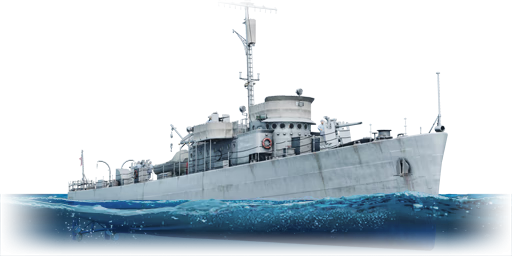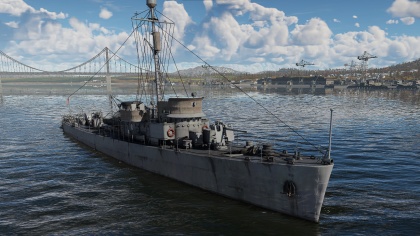Difference between revisions of "Carmi (PC-466)"
CobraKingII (talk | contribs) (→History) |
CobraKingII (talk | contribs) (→History) (Tag: Visual edit) |
||
| Line 47: | Line 47: | ||
The ship was layed down on September 1, 1941 by George Lawley and Sons in Neponset, Massachusetts. It was launched on April 29, 1942, and was named the '''''USS PC-466'''''. It was originally classified as a submarine chaser, but was re-designated as a control submarine chaser on August 20, 1945, and was named the '''''USS PCC-466'''''. During the Japanese surrender the '''''USS PCC-466''''' was present in Tokyo Bay, in September of 1945. It was decommissioned on March 1, 1947 and was sent to the Pacific Reserve Fleet, Columbia River Group, in Astoria, Oregon. It was once more classified as a submarine chaser, '''''PC-466''''', on October 27, 1955. It was named the '''''Carmi''''' on February 1, 1956, and was sold for scrap in 1960. | The ship was layed down on September 1, 1941 by George Lawley and Sons in Neponset, Massachusetts. It was launched on April 29, 1942, and was named the '''''USS PC-466'''''. It was originally classified as a submarine chaser, but was re-designated as a control submarine chaser on August 20, 1945, and was named the '''''USS PCC-466'''''. During the Japanese surrender the '''''USS PCC-466''''' was present in Tokyo Bay, in September of 1945. It was decommissioned on March 1, 1947 and was sent to the Pacific Reserve Fleet, Columbia River Group, in Astoria, Oregon. It was once more classified as a submarine chaser, '''''PC-466''''', on October 27, 1955. It was named the '''''Carmi''''' on February 1, 1956, and was sold for scrap in 1960. | ||
| + | |||
| + | The ship had a displacement of 280 t, a length of 173 ft 8 in, a beam of 23 ft, and a draft of 10 ft 10 in. It was powered by two 1,440 bhp Fairbanks Morse 38D8 1/8 diesel engines, and featured a Westinhouse single reduction gear, and had two shafts. The armament consisted of one 3"/50 dual purpose gun mount, one 40mm gun mount, three 20mm guns, two rocket launchers, four depth charge projectors, and two depth charge racks. The crew complement was 65 sailors and officers, and the maximum speed was 20.2 knots. | ||
== Media == | == Media == | ||
| Line 66: | Line 68: | ||
{{USA sub-chasers}} | {{USA sub-chasers}} | ||
{{USA premium ships}} | {{USA premium ships}} | ||
| + | |||
| + | == Bibliography == | ||
| + | |||
| + | * Priolo, Gary P. Carmi PC-466. NavSource Naval History. http://www.navsource.org/archives/12/010466.htm | ||
Revision as of 15:26, 23 May 2020
Contents
Description
The PC-461-class, Carmi (PC-466) is a premium rank II American sub-chaser
with a battle rating of 2.3 (AB/RB/SB). It was introduced in Update 1.91 "Night Vision".
General info
Survivability and armour
Talk about the vehicle's armour. Note the most well-defended and most vulnerable zones, e.g. the ammo magazine. Evaluate the composition of components and assemblies responsible for movement and manoeuvrability. Evaluate the survivability of the primary and secondary armaments separately. Don't forget to mention the size of the crew, which plays an important role in fleet mechanics. Save tips on preserving survivability for the "Usage in battles" section. If necessary, use a graphical template to show the most well-protected or most vulnerable points in the armour.
Mobility
Write about the ship's mobility. Evaluate its power and manoeuvrability, rudder rerouting speed, stopping speed at full tilt, with its maximum forward and reverse speed.
Armament
Primary armament
Provide information about the characteristics of the primary armament. Evaluate their efficacy in battle based on their reload speed, ballistics and the capacity of their shells.
Broadly describe the ammunition available for the primary armament, and provide recommendations on how to use it and which ammunition to choose.
Secondary armament
Some ships are fitted with weapons of various calibres. Secondary armaments are defined as weapons chosen with the control Select secondary weapon. Evaluate the secondary armaments and give advice on how to use them. Describe the ammunition available for the secondary armament. Provide recommendations on how to use them and which ammunition to choose. Remember that any anti-air armament, even heavy calibre weapons, belong in the next section. If there is no secondary armament, remove this section.
Special armament
Depth charges, mines, rocket launchers and missiles are also effective in skilled hands and can take an off-guard opponent by surprise. Evaluate the ammunition of this type of armament and rate its performance in combat. If there are no special armaments, remove this section.
Usage in battles
Describe the technique of using this ship, the characteristics of her use in a team and tips on strategy. Abstain from writing an entire guide – don't try to provide a single point of view, but give the reader food for thought. Talk about the most dangerous opponents for this vehicle and provide recommendations on fighting them. If necessary, note the specifics of playing with this vehicle in various modes (AB, RB, SB).
Pros and cons
Summarise and briefly evaluate the vehicle in terms of its characteristics and combat effectiveness. Mark its pros and cons in the bulleted list. Try not to use more than 6 points for each of the characteristics. Avoid using categorical definitions such as "bad", "good" and the like - use substitutions with softer forms such as "inadequate" and "effective".
Pros:
Cons:
History
The ship was layed down on September 1, 1941 by George Lawley and Sons in Neponset, Massachusetts. It was launched on April 29, 1942, and was named the USS PC-466. It was originally classified as a submarine chaser, but was re-designated as a control submarine chaser on August 20, 1945, and was named the USS PCC-466. During the Japanese surrender the USS PCC-466 was present in Tokyo Bay, in September of 1945. It was decommissioned on March 1, 1947 and was sent to the Pacific Reserve Fleet, Columbia River Group, in Astoria, Oregon. It was once more classified as a submarine chaser, PC-466, on October 27, 1955. It was named the Carmi on February 1, 1956, and was sold for scrap in 1960.
The ship had a displacement of 280 t, a length of 173 ft 8 in, a beam of 23 ft, and a draft of 10 ft 10 in. It was powered by two 1,440 bhp Fairbanks Morse 38D8 1/8 diesel engines, and featured a Westinhouse single reduction gear, and had two shafts. The armament consisted of one 3"/50 dual purpose gun mount, one 40mm gun mount, three 20mm guns, two rocket launchers, four depth charge projectors, and two depth charge racks. The crew complement was 65 sailors and officers, and the maximum speed was 20.2 knots.
Media
Excellent additions to the article would be video guides, screenshots from the game, and photos.
See also
Links to articles on the War Thunder Wiki that you think will be useful for the reader, for example:
- reference to the series of the ship;
- links to approximate analogues of other nations and research trees.
External links
Paste links to sources and external resources, such as:
- topic on the official game forum;
- encyclopedia page on the ship;
- other literature.
| USA sub-chasers | |
|---|---|
| USA premium ships | |
|---|---|
| Motor torpedo boats | PT-3 · PT-109 · PT-174 · Thunderbolt (PT-556) · PT-658 · PT-811 |
| Motor gun boats | LCM(6) Zippo · USS Douglas · USS Flagstaff |
| Sub-chasers | Carmi (PC-466) |
| Destroyers | USS Welborn C. Wood · USS Wilkinson · USS Bennion · USS Cowell · USS Davis · USS Moffett · USS Phelps · USS Frank Knox |
| Light cruisers | USS Detroit · USS Helena |
| Heavy cruisers | USS Des Moines |
| Battleships | USS Arkansas |
Bibliography
- Priolo, Gary P. Carmi PC-466. NavSource Naval History. http://www.navsource.org/archives/12/010466.htm





